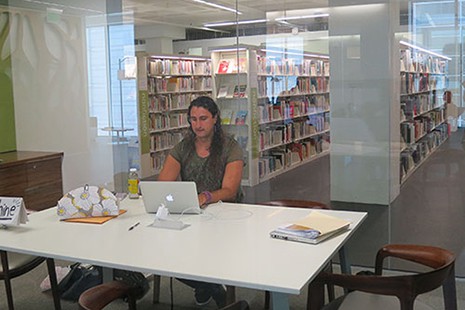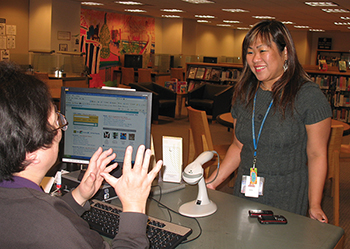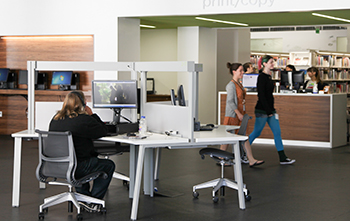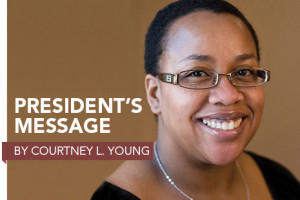
Just before 9 a.m. on a Tuesday in Madison, Wisconsin, people line up on the corner outside Madison Public Library, waiting for the doors to open. Some of them have spent the night on nearby street benches or on the pavement near the building. They’re ready for a soft chair and dry air.
“First in, last to leave the library,” says Jane, describing herself and her homeless community. “It’s our routine.” Jane, who prefers not to give her last name, says she’s classified as chronically homeless.
The US Department of Housing and Urban Development defines a chronically homeless person as an unaccompanied individual with a disabling condition who has either been continuously homeless for one year or more or has experienced at least four episodes of homelessness in the last three years. More than 610,000 people are homeless in the United States on any given night. Nearly two-thirds live in shelters or transitional housing, and the rest are unsheltered.
Jane says she didn’t start coming to the library until she became homeless. Now she’s drawn to it for many reasons; it’s one of the few places she can go where it doesn’t matter what she wears or whether she has money. She’s entitled to the same services and treatment as the person standing next to her in a designer coat.
The American Library Association (ALA) maintains in its “Library Services to the Poor” policy statement that it’s crucial for public libraries to recognize their role in enabling poor people to participate fully in a democratic society. The library has to serve as a uniquely egalitarian place. Moreover, library staffers have a duty to look out for the needs of poor and homeless patrons and strive to provide relevant services.
That’s a complex task for librarians who already face a number of challenges.
How do you make the public library a welcoming place for everyone when not all library users (or even staff members) feel comfortable around signs of homelessness? What if a homeless patron needs professional services beyond the library’s capability to fulfill? Madison Public Library and several other public libraries have come up with practical, innovative solutions.
The library allure
According to Partners Ending Homelessness, there are three patterns of homelessness. Situational homelessness can occur when someone loses a job, gets evicted, or suffers a particular financial or health crisis. Episodic homelessness differs in that it stems from patterns of behavior and can have multiple causes, including depression and domestic violence, and is more common among women and families. A third group—chronically homeless people—comprises less than 18% of the total homeless population.
Librarians who work with homeless populations should understand the different types of homelessness, says Ryan Dowd, former director of the Hesed House, a homeless shelter in Aurora, Illinois. Dowd says chronically homeless people typically present the most challenges for libraries. Homelessness for them doesn’t stem from poverty alone but from poverty combined with the lack of relationships or support systems.
“If you think about the variety of issues that face the homeless, in many ways they’re not connected to society,” says Jill Bourne, director of San José (Calif.) Public Library. “The library may be the only place where they can go to be connected. It can be a lifeline.”
“At the library, you can get on the computer and find out what’s going on in the world,” says Jane in Madison. “If Obama’s going to Zimbabwe, I know.” She also spends time online searching for jobs and affordable housing. The library not only helps her connect with the world at large but also helps her disconnect from aspects of her immediate surroundings.
Most homeless people don’t sleep by themselves on the street, according to Jane. They sleep in a community, often in the same spots, and it’s never safe. “Here there are boundaries,” says Jane, pointing to a computer pod at Madison Public Library. “Those people have their own section of the table. That’s their own space. That’s gold.”
Other homeless patrons come to the library because they need support services and aren’t sure where else to go. Nearly one-third of all chronically homeless people suffer from a mental illness, and about half face substance abuse problems, according to the Substance Abuse and Mental Health Services Administration.
In his work at the Aurora shelter, Dowd noticed a high incidence of autism among homeless populations. Many people with autism spectrum disorders experience sensory sensitivity, which may add to the appeal of a library; they find a peaceful refuge from the noise and glare of the street.
Day-to-day challenges
Chicago Public Library posts policies online that prohibit sleeping and other behaviors sometimes associated with the homeless community. These include loitering, panhandling, bathing in the bathrooms, carrying in large or multiple bags, and offensive hygiene. Complaints from patrons have prompted other libraries to adopt similar policies.
But those policies pose unique challenges to homeless people. Homelessness is an exhausting lifestyle, says Dorothy Sterling, a homeless Chicago Public Library patron. Those who live on the street typically carry everything they own with them, and they’re afraid to fall asleep for fear someone may steal their belongings. “Most of the homeless, we walk all night,” she says. “Your body just shuts down. And I haven’t found a library yet that will let you be when that happens.”
Patrick Molloy, director of government and public affairs at Chicago Public Library, says the library enforces its policy against sleeping because of safety concerns. “It’s difficult to know if something could be wrong,” Molloy says. “The librarians will wake people up to ask if they’re okay.” Unless the behavior is illegal, he says the library gives patrons a second chance to follow library policies before asking them to leave. Patrons are then welcome back the next day.
“We always want to be open and welcoming to all,” says Anne Haimes, interim director of the Atlanta-Fulton Public Library System in Georgia. “However, we do need to make sure that everyone who comes in feels safe and comfortable.” The challenge for libraries is finding that balance. Haimes says for her library system, keeping a strong, flexible code of conduct helps.
And success can hinge on the word “flexible.” Many homeless people are victims of a shrinking social safety net, says Rene Heybach, senior counsel at the Law Project of the Chicago Coalition for the Homeless. Libraries need to address signs of homelessness in a nonstigmatizing way, she says, and look for ways to “make room under the public tent.”
Heybach helped craft legislation for the Homeless Bill of Rights, currently adopted into law in Connecticut, Illinois, and Rhode Island. The bill takes aim at city ordinances that ban activities such as sleeping and loitering in public spaces—activities inherent to homelessness. Such laws criminalize the existence of homeless people, according to the National Law Center on Homelessness and Poverty.
Among its protections, the bill states that homeless people cannot be denied access to public spaces solely based on their housing status. That’s a point to consider in regard to library policies, such as restrictions against carry-in items. Because of their housing status, homeless people may not have a place to store their bags and therefore can’t enter a building.
The best way to ensure open access is to keep an open dialogue, says San José’s Bourne. “Make it about sharing a space.” If a patron comes in with an oversize item and it’s blocking the corridor, San José Public Library trains its staff members to work the problem and not be too rigid about rules. They’ll ask, “Could you possibly fit that under here so people can get by?” she says.
Bourne says she’s also careful to ensure policies are broad enough to implement across the library’s entire user base, which includes university students. Students will often nod off while studying for exams, making a ban on sleeping impractical. Unless staffers can enforce policies consistently among all library patrons and not only the poor, they risk profiling based on poverty.
“We used to have a set of policies that read like the Ten Commandments,” says Bob Harris, recently retired director of the Helen Plum Memorial Library in Lombard, Illinois. At the advice of a security consultant, the library now sticks to one main rule: If you’re doing something that interferes with someone else’s use of the library, it’s not allowed. “Anything else? You’re probably okay,” says Harris. Unless they’re snoring, dozers go undisturbed.
When patrons complain, it’s usually not the presence of homeless people that bothers them, says Harris. “It’s the perception that they’re dangerous.”
What libraries can do

Many public libraries are working to overcome these misconceptions and break the public stigma of homelessness. It takes research, networking, and some ingenuity.
Know your homeless population
The Annual Homeless Assessment Report compiled by the US Department of Housing and Urban Development provides statistics by state as well as local planning bodies. School districts are a good source of information too, since they’re required to count and report on the number of homeless students. Other places to gather research include local food pantries, churches, community organizations that target services to the poor, homeless shelters, and transitional housing facilities.
The most knowledgeable source is, of course, homeless patrons already in the library. Not everyone will want to talk, but those who do can provide insight into why they visit and what additional services they would like to see the library offer.
Form a provider web
While canvassing for information, libraries should look for potential partnerships: service providers that can address the needs of their particular community. A San José study found that 60% of the homeless people in the city suffer from one or more disabling conditions. The library doesn’t have staffers trained to handle those issues, so they built relationships with agencies that do.
“Because libraries are the day shelter in a lot of cities, we have to find a way to knit together services,” says Bourne. Libraries can take a leading role in starting that conversation and building a consortium of service providers vested in helping the homeless.
In Lombard, Helen Plum Memorial Library trustee Kris Johnson convened several community forums at the library to discuss ongoing issues relating to homelessness. Every Tuesday, the homeless shelter near the library hosts a shelter night, and the neighborhood sees an influx of homeless people. Many would wait in and around the library until the shelter opened its doors at 7 p.m.
At the forum, the village president, board members, and representatives from area churches and organizations talked about how to improve the situation. Now, a staff of community volunteers hosts a movie screening at the library before the shelter opens, serving popcorn and cocoa donated by Johnson.
Bring resources in-house
Once, when homeless patrons needed help with personal problems like addiction or domestic abuse, libraries could offer only a referral and direct them someplace else. That’s not always effective, since many homeless people suffer from low self-esteem and have difficulty trusting, says Dowd. Other agencies may have failed them before, so they could decide it’s not worth the risk.
But the public library is different. It already has the trust of the homeless community, many of whom stay at the library all day. “It’s like a home,” says Sterling. By bringing resources in-house, libraries can help ensure homeless patrons have access to services critical to their welfare.
In 2008, San Francisco Public Library became the nation’s first public library to hire its own, full-time psychiatric social worker, according to Michelle Jeffers, chief of community programs and partnerships. Soon after the social worker started, the library hired four health and safety advocates (HASAs), each of whom were formerly homeless themselves.
HASAs help promote services to the poor, including a resource fair that the library hosts in partnership with Project Homeless Connect. Every month in the library’s auditorium, agencies set up booths offering resources and services geared to the homeless, such as eyeglasses, vaccines, shoes, and haircuts.
Public libraries in other cities, including San José, Madison, Philadelphia, and Salt Lake City, also have social workers in-house. Z! Haukeness from the Shine Initiative—a nonprofit based in Madison—keeps a prominent profile in a glass room in the middle of Madison Public Library, where he and a coworker spend 30 hours a week helping patrons find housing and jobs and apply for food stamps. Some people come just to talk through hardships, he says.
One hardship of homelessness, the inability to bathe, has caused ongoing problems for public libraries. San Francisco Public Library now has a possible solution: mobile showers. When a local nonprofit, Lava Mae, began retrofitting former city buses with private showers for the homeless, SFPL staffers lobbied to have one parked outside the central library. Open to all, the free showers would include soap, shampoo, and towels.
Lava Mae’s founders are looking to expand their model to other cities, according to the nonprofit’s website.
Create welcoming spaces
During the planning phases of Madison Public Library’s recent building renovation, director Greg Mickells met with several social service agencies to discuss how to make the library a more inviting and functional space for all patrons, particularly Madison’s homeless community.
The new facility features workspace for 10 different social agencies like the Shine Initiative, as well as redesigned work areas for patrons. Unlike computer banks where people sit in rows, the library’s work areas look more like pods: clusters of three computer desks with partitions spread throughout the library. This arrangement provides more privacy—a valued commodity among homeless patrons.
Librarians can also expand their collections to include materials on poverty and homelessness, and make sure everyone has access to checking them out. ALA recommends removing restrictions to owning a library card. “There are a lot of educated homeless people,” says Sterling. “We like to read and to learn.” She adds that she arrives at the library as soon as it opens to surf the web, and attends the library’s free seminars on issues relating to consumer credit and the law.
Some libraries allow patrons to use a shelter address when applying for a library card. About 2% of all the cards that Atlanta-Fulton Public Library System issues are courtesy cards for people without a permanent address, says Haimes. Of those, 95% go to homeless people.
Offer targeted programs
After learning about a program at the Dallas Public Library called “Coffee and Conversation,” SFPL’s Jeffers says colleagues decided to try the idea. Homeless patrons gather to share experiences and struggles and talk about why they come to the library. An informal coffee klatch can help stir up ideas for a host of other programs.
Another good source is ALA’s toolkit, “Extending Our Reach: Reducing Homelessness through Library Engagement.” The source contains a list of programs of interest to homeless people, such as mortgage or rental assistance, help applying for government benefits, and health programs.
Libraries like Atlanta-Fulton Public Library System also offer free GED classes on-site that draw unemployed or underemployed people who may be experiencing episodic homelessness. A report from the Institute for Children, Poverty, and Homelessness shows nearly 50% of homeless parents are high school dropouts. Obtaining a GED can offer the pathway to gainful employment, and for some, a way off the street.
Train staff
“When you see a homeless person, you see the bags and the raggedy coat, [but] you don’t always see the human,” says Harris of Lombard. “I try to look directly into the person’s eyes.” He says he learned about the importance of making eye contact and other tips from Dowd’s YouTube video, “A Librarian’s Guide to Homelessness.” It’s now required viewing for all staffers at Helen Plum Memorial Library, which serves a large homeless population.
The video offers some insights into what it’s like to be homeless and can help foster sensitivity toward related issues. Dowd recommends treating homeless people no better or worse than anyone else; they don’t mind rules so long as they’re applied fairly. “[The] catch is how they’re enforced,” he says. Underpinning all his advice is one principle: Show respect.
“People just don’t understand being a homeless person,” says Sterling. “If you respect them, they’ll respect you.”
That simple concept isn’t always simple in practice. Each person in the homeless community has a story about how he or she got there. Some of those stories include abuse, mental illness, and posttraumatic stress. As a result, homeless people can often feel cast off from society.
Libraries can work to change that. In addition to providing vital resources, library staffers can engage their communities in better understanding the issues surrounding homelessness. But they can’t do it alone. Working with other advocates and social agencies, libraries can create resource-rich spaces where homeless patrons feel welcome, intellectually engaged, and connected with their communities.


